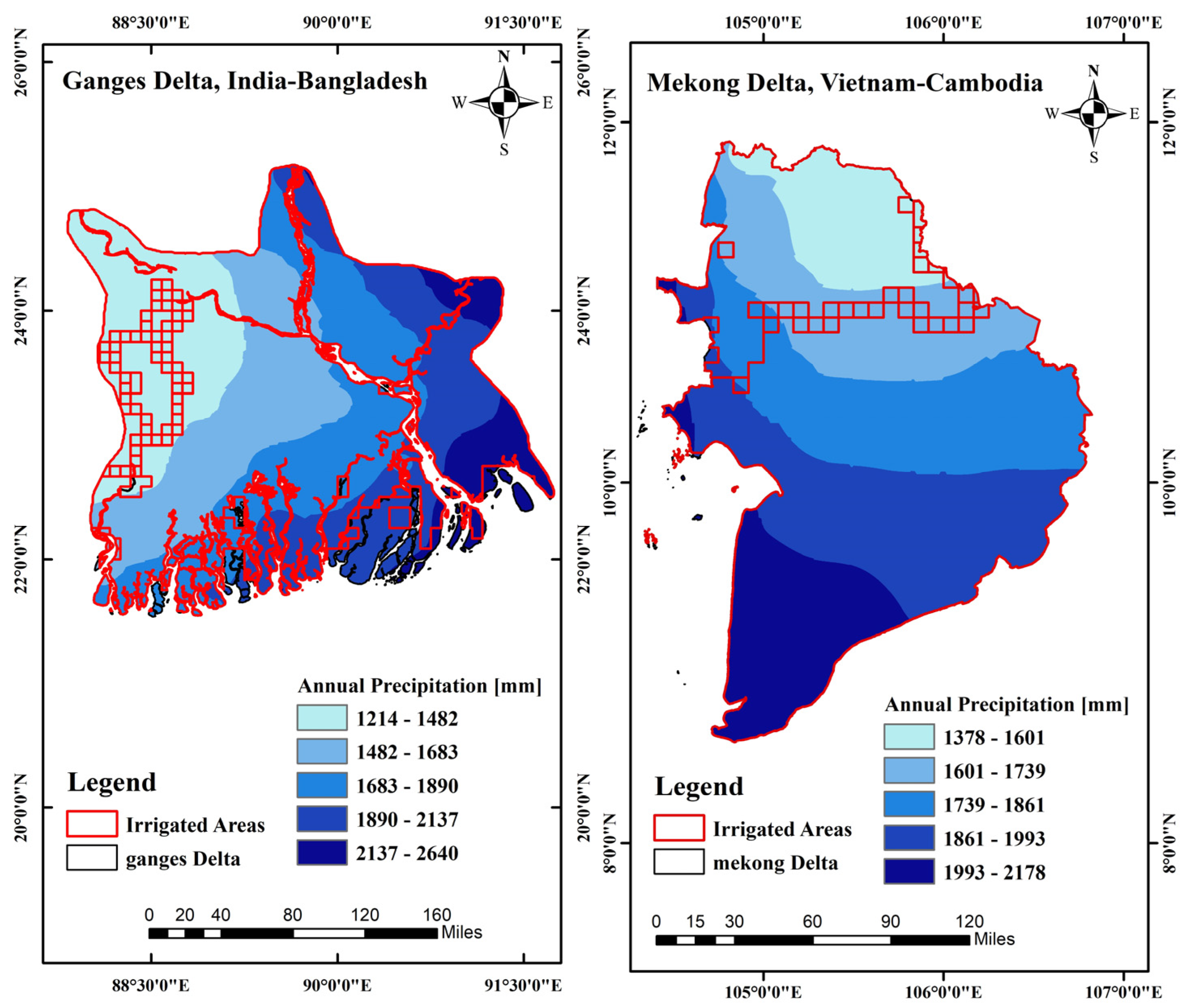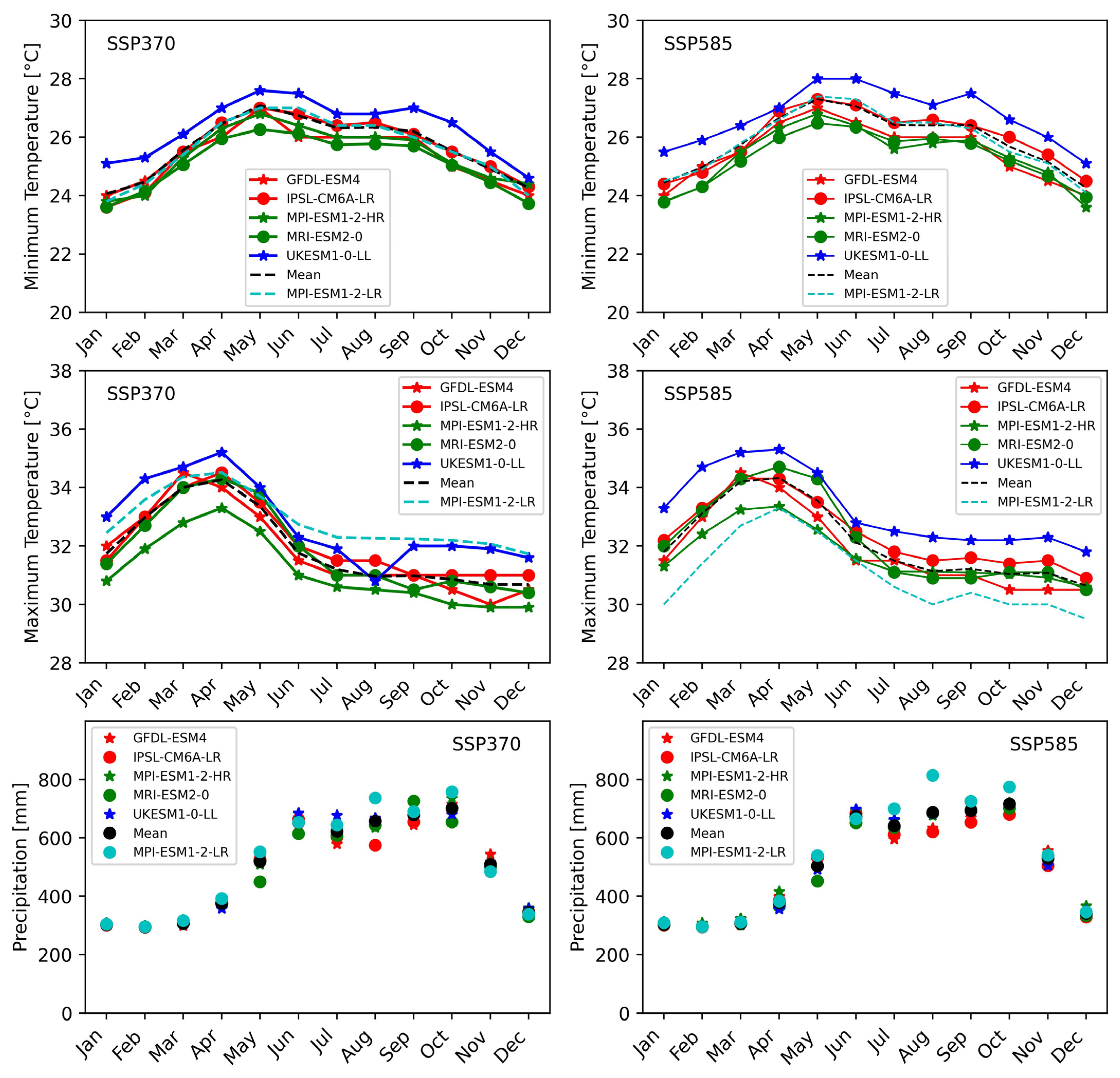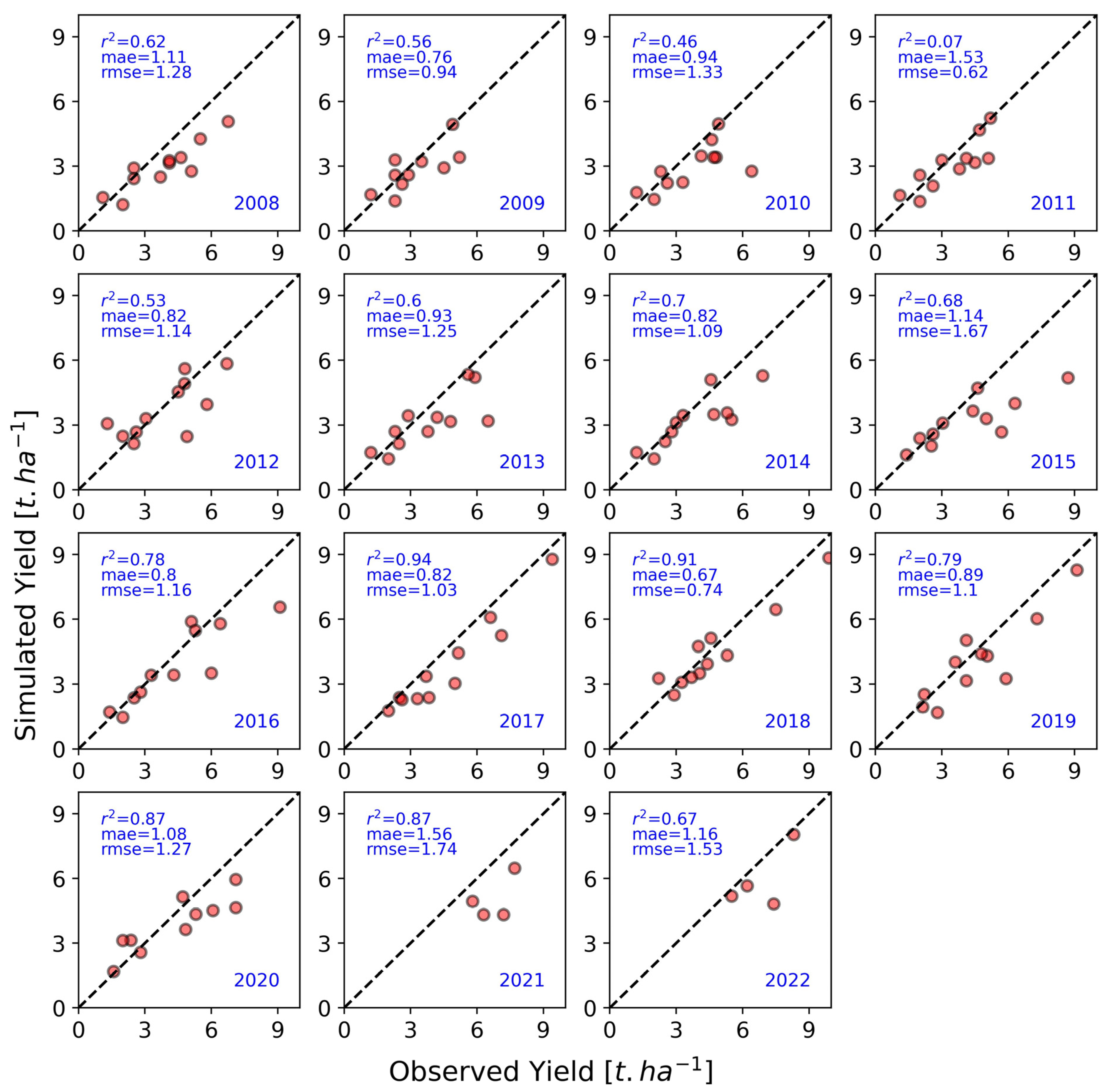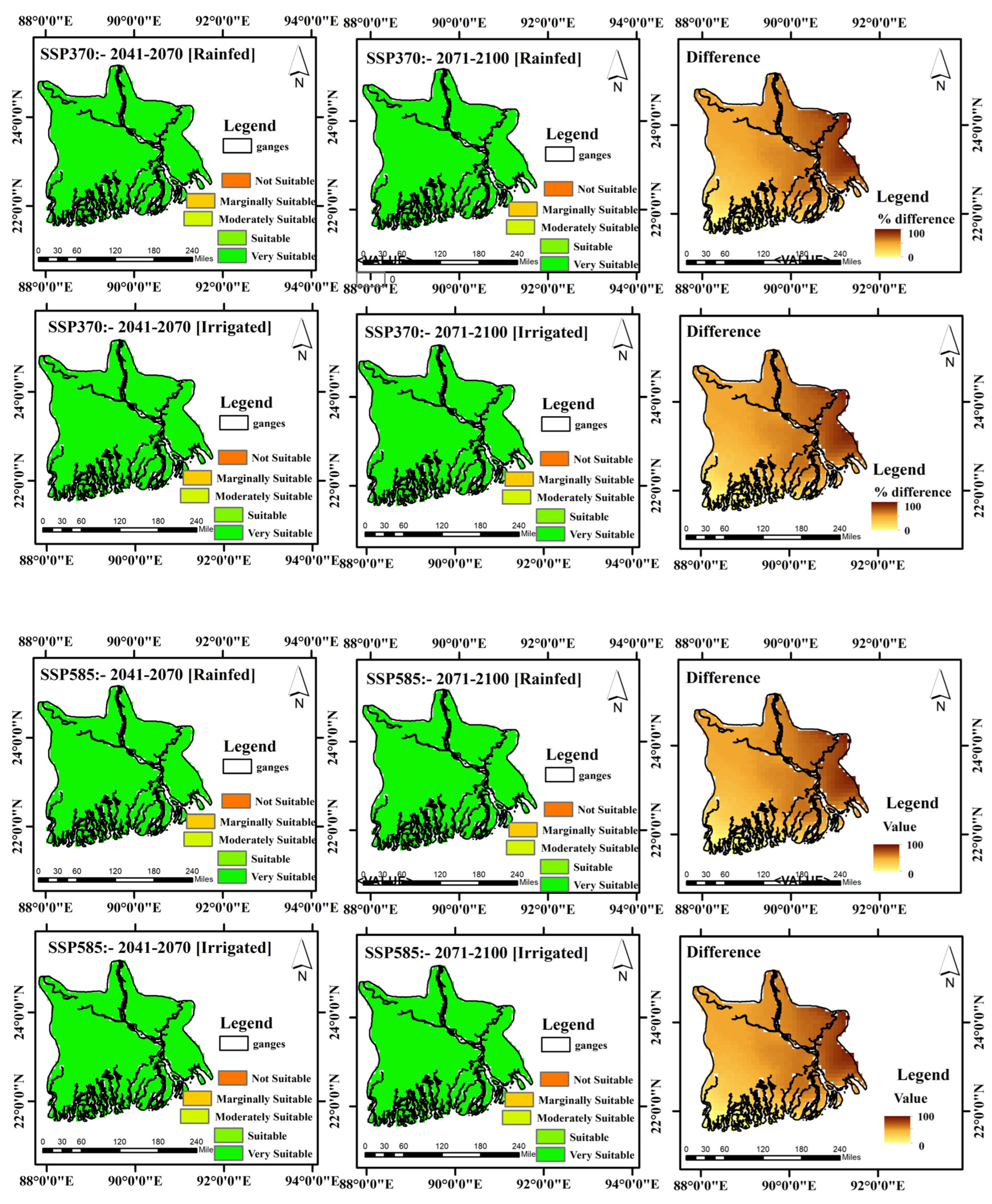Maize Yield Suitability Mapping in Two Major Asian Mega-Deltas Using AgERA and CMIP6 Climate Projections in Crop Modeling
Abstract
1. Introduction
2. Materials and Methods
2.1. Study Sites
2.2. Data
2.3. Method
2.3.1. Downscaling CMIP6 Climate Projections Using Statistical Method
2.3.2. PyAEZ-Based Crop Suitability and Yield Mapping
2.3.3. Yield Modeling
2.4. Validation
3. Results
3.1. Crop Yield Modeling and Suitability Mapping–Ganges Delta
3.1.1. Using Historical Climate Data from AgERA
3.1.2. Using CMIP6 Climate Projections
3.2. Crop Yield Modeling and Suitability Mapping—Mekong Delta
3.2.1. Using Historical Climate Data from AgERA
3.2.2. Using CMIP6 Climate Projections
4. Discussion
4.1. Downscaling CMIP6 Climate Projections
4.2. Crop Yield Modeling and Suitability Mapping, Ganges Delta, India–Bangladesh
4.3. Crop Yield Modeling and Suitability Mapping, Mekong Delta, Vietnam–Cambodia
5. Conclusions
Supplementary Materials
Author Contributions
Funding
Data Availability Statement
Acknowledgments
Conflicts of Interest
Abbreviations
| AgERA | European Centre for Medium-Range Weather Forecast Reanalysis for Agriculture |
| AMD | Asian Mega-Delta |
| AEZ | Agro-ecological Zones |
| CHELSA | Climatologies at high resolution for the earth’s land and surface area |
| CMIP6 | Coupled Model Intercomparison Phase 6 |
| ESGF | Earth System Grid Federation |
| FAO | Food and Agriculture Organization |
| GAEZ | Global Agro-ecological Zone |
| GCM | Global Circulation Model |
| GIS | Geographic Information System |
| HWSD | Harmonized World Soil Database |
| IPCC | Intergovernmental Panel on Climate Change |
| LULC | Land-use land-cover |
| MCDA | Multi-Criteria Decision Analysis |
| PyAEZ | Python-based Agro-ecological Zoning framework |
| SSP | Socioeconomic Pathway |
| SRTM | Shuttle Radar Topography Mission |
References
- Fischer, G.; Nachtergaele, F.O.; Van Velthuizen, H.; Chiozza, F.; Francheschini, G.; Henry, M.; Muchoney, D.; Tramberend, S. Global Agro-Ecological Zones (Gaez v4)-Model Documentation; Food and Agriculture Organization: Rome, Italy, 2021. [Google Scholar]
- Schneider, P.; Asch, F. Rice Production and Food Security in Asian Mega Deltas—A Review on Characteristics, Vulnerabilities and Agricultural Adaptation Options to Cope with Climate Change. J. Agron. Crop Sci. 2020, 206, 491–503. [Google Scholar] [CrossRef]
- Asseng, S.; Ewert, F.; Martre, P.; Rötter, R.P.; Lobell, D.B.; Cammarano, D.; Kimball, B.A.; Ottman, M.J.; Wall, G.W.; White, J.W. Rising Temperatures Reduce Global Wheat Production. Nat. Clim. Change 2015, 5, 143–147. [Google Scholar] [CrossRef]
- Lesk, C.; Coffel, E.; Winter, J.; Ray, D.; Zscheischler, J.; Seneviratne, S.I.; Horton, R. Stronger Temperature–Moisture Couplings Exacerbate the Impact of Climate Warming on Global Crop Yields. Nat. Food 2021, 2, 683–691. [Google Scholar] [CrossRef] [PubMed]
- Ortiz-Bobea, A.; Ault, T.R.; Carrillo, C.M.; Chambers, R.G.; Lobell, D.B. Anthropogenic Climate Change Has Slowed Global Agricultural Productivity Growth. Nat. Clim. Change 2021, 11, 306–312. [Google Scholar] [CrossRef]
- Arias, P.; Bellouin, N.; Coppola, E.; Jones, R.; Krinner, G.; Marotzke, J.; Naik, V.; Palmer, M.; Plattner, G.-K.; Rogelj, J. Climate Change 2021: The Physical Science Basis; Contribution of Working Group I to the Sixth Assessment Report of the Intergovernmental Panel on Climate Change; Technical Summary; IPCC: Geneva, Switzerland, 2021. [Google Scholar]
- Jägermeyr, J.; Müller, C.; Ruane, A.C.; Elliott, J.; Balkovic, J.; Castillo, O.; Faye, B.; Foster, I.; Folberth, C.; Franke, J.A. Climate Impacts on Global Agriculture Emerge Earlier in New Generation of Climate and Crop Models. Nat. Food 2021, 2, 873–885. [Google Scholar] [CrossRef]
- Asseng, S.; Martre, P.; Maiorano, A.; Rötter, R.P.; O’Leary, G.J.; Fitzgerald, G.J.; Girousse, C.; Motzo, R.; Giunta, F.; Babar, M.A. Climate Change Impact and Adaptation for Wheat Protein. Glob. Change Biol. 2019, 25, 155–173. [Google Scholar] [CrossRef]
- Challinor, A.J.; Watson, J.; Lobell, D.B.; Howden, S.M.; Smith, D.R.; Chhetri, N. A Meta-Analysis of Crop Yield under Climate Change and Adaptation. Nat. Clim. Change 2014, 4, 287–291. [Google Scholar] [CrossRef]
- Lobell, D.B.; Burke, M.B.; Tebaldi, C.; Mastrandrea, M.D.; Falcon, W.P.; Naylor, R.L. Prioritizing Climate Change Adaptation Needs for Food Security in 2030. Science 2008, 319, 607–610. [Google Scholar] [CrossRef]
- Rising, J.; Devineni, N. Crop Switching Reduces Agricultural Losses from Climate Change in the United States by Half under RCP 8.5. Nat. Commun. 2020, 11, 4991. [Google Scholar] [CrossRef]
- Hammer, G.L.; McLean, G.; Chapman, S.; Zheng, B.; Doherty, A.; Harrison, M.T.; van Oosterom, E.; Jordan, D. Crop Design for Specific Adaptation in Variable Dryland Production Environments. Crop Pasture Sci. 2014, 65, 614–626. [Google Scholar] [CrossRef]
- Peng, B.; Guan, K.; Tang, J.; Ainsworth, E.A.; Asseng, S.; Bernacchi, C.J.; Cooper, M.; Delucia, E.H.; Elliott, J.W.; Ewert, F. Towards a Multiscale Crop Modelling Framework for Climate Change Adaptation Assessment. Nat. Plants 2020, 6, 338–348. [Google Scholar] [CrossRef]
- Jiang, R.; He, W.; He, L.; Yang, J.Y.; Qian, B.; Zhou, W.; He, P. Modelling Adaptation Strategies to Reduce Adverse Impacts of Climate Change on Maize Cropping System in Northeast China. Sci. Rep. 2021, 11, 810. [Google Scholar] [CrossRef] [PubMed]
- Zhang, Y.; Zhao, Y.; Sun, Q. Increasing Maize Yields in Northeast China Are More Closely Associated with Changes in Crop Timing than with Climate Warming. Environ. Res. Lett. 2021, 16, 054052. [Google Scholar] [CrossRef]
- Moeletsi, M.E.; Walker, S. Agroclimatological Suitability Mapping for Dryland Maize Production in Lesotho. Theor. Appl. Climatol. 2013, 114, 227–236. [Google Scholar] [CrossRef]
- Ben-Ari, T.; Adrian, J.; Klein, T.; Calanca, P.; Van der Velde, M.; Makowski, D. Identifying Indicators for Extreme Wheat and Maize Yield Losses. Agric. For. Meteorol. 2016, 220, 130–140. [Google Scholar] [CrossRef]
- Reidsma, P.; Ewert, F.; Oude Lansink, A.; Leemans, R. Vulnerability and Adaptation of European Farmers: A Multi-Level Analysis of Yield and Income Responses to Climate Variability. Reg. Environ. Change 2009, 9, 25. [Google Scholar] [CrossRef]
- Bolton, D.K.; Friedl, M.A. Forecasting Crop Yield Using Remotely Sensed Vegetation Indices and Crop Phenology Metrics. Agric. For. Meteorol. 2013, 173, 74–84. [Google Scholar] [CrossRef]
- Dhami, J.; Roy, S.; Nain, A.S.; Panwar, R. Suitability Analysis of Apple and Pear Using Remote Sensing and GIS in Uttarakhand. J. Agrometeorol. 2012, 14, 464–474. [Google Scholar]
- Mendas, A.; Delali, A. Integration of MultiCriteria Decision Analysis in GIS to Develop Land Suitability for Agriculture: Application to Durum Wheat Cultivation in the Region of Mleta in Algeria. Comput. Electron. Agric. 2012, 83, 117–126. [Google Scholar] [CrossRef]
- Zolekar, R.B.; Bhagat, V.S. Multi-Criteria Land Suitability Analysis for Agriculture in Hilly Zone: Remote Sensing and GIS Approach. Comput. Electron. Agric. 2015, 118, 300–321. [Google Scholar] [CrossRef]
- Rodcha, R.; Tripathi, N.K.; Prasad Shrestha, R. Comparison of Cash Crop Suitability Assessment Using Parametric, AHP, and FAHP Methods. Land 2019, 8, 79. [Google Scholar] [CrossRef]
- Jain, R.; Chand, P.; Rao, S.C.; Agarwal, P. Crop and Soil Suitability Analysis Using Multi-Criteria Decision Making in Drought-Prone Semi-Arid Tropics in India. J. Soil. Water Conserv. 2020, 19, 271–283. [Google Scholar] [CrossRef]
- Chavez, M.D.; Berentsen, P.B.; Lansink, A.O. Assessment of Criteria and Farming Activities for Tobacco Diversification Using the Analytical Hierarchical Process (AHP) Technique. Agric. Syst. 2012, 111, 53–62. [Google Scholar] [CrossRef]
- Yalew, S.G.; Van Griensven, A.; van der Zaag, P. AgriSuit: A Web-Based GIS-MCDA Framework for Agricultural Land Suitability Assessment. Comput. Electron. Agric. 2016, 128, 1–8. [Google Scholar] [CrossRef]
- Ranjan, R.; Nain, A.; Jha, A. Assessment of Land Suitability Potentials of Willow for Enhancing Green Cover under Wastelands of Haryana Using Geospatial Technology. J. Agrometeorol. 2018, 20, 44–48. [Google Scholar]
- Akıncı, H.; Özalp, A.Y.; Turgut, B. Agricultural Land Use Suitability Analysis Using GIS and AHP Technique. Comput. Electron. Agric. 2013, 97, 71–82. [Google Scholar] [CrossRef]
- Houshyar, E.; SheikhDavoodi, M.J.; Almassi, M.; Bahrami, H.; Azadi, H.; Omidi, M.; Sayyad, G.; Witlox, F. Silage Corn Production in Conventional and Conservation Tillage Systems. Part I: Sustainability Analysis Using Combination of GIS/AHP and Multi-Fuzzy Modeling. Ecol. Indic. 2014, 39, 102–114. [Google Scholar] [CrossRef]
- Romano, G.; Dal Sasso, P.; Liuzzi, G.T.; Gentile, F. Multi-Criteria Decision Analysis for Land Suitability Mapping in a Rural Area of Southern Italy. Land Use Policy 2015, 48, 131–143. [Google Scholar] [CrossRef]
- Chivasaa, W.; Mutanga, O.; Biradarc, C. Mapping Land Suitability for Maize (Zea mays L.) Production Using GIS and AHP Technique in Zimbabwe. S. Afr. J. Geomat. 2019, 8, 265–281. [Google Scholar] [CrossRef]
- Ramamurthy, V.; Reddy, G.O.; Kumar, N. Assessment of Land Suitability for Maize (Zea mays L.) in Semi-Arid Ecosystem of Southern India Using Integrated AHP and GIS Approach. Comput. Electron. Agric. 2020, 179, 105806. [Google Scholar] [CrossRef]
- Dorigo, W.A.; Zurita-Milla, R.; de Wit, A.J.; Brazile, J.; Singh, R.; Schaepman, M.E. A Review on Reflective Remote Sensing and Data Assimilation Techniques for Enhanced Agroecosystem Modeling. Int. J. Appl. Earth Obs. Geoinf. 2007, 9, 165–193. [Google Scholar] [CrossRef]
- Doraiswamy, P.C.; Moulin, S.; Cook, P.W.; Stern, A. Crop Yield Assessment from Remote Sensing. Photogramm. Eng. Remote Sens. 2003, 69, 665–674. [Google Scholar] [CrossRef]
- Haun, J.R. Prediction of Spring Wheat Yields from Temperature and Precipitation Data 1. Agron. J. 1974, 66, 405–409. [Google Scholar] [CrossRef]
- Moulin, S.; Bondeau, A.; Delecolle, R. Combining Agricultural Crop Models and Satellite Observations: From Field to Regional Scales. Int. J. Remote Sens. 1998, 19, 1021–1036. [Google Scholar] [CrossRef]
- Xin, Q.; Gong, P.; Yu, C.; Yu, L.; Broich, M.; Suyker, A.E.; Myneni, R.B. A Production Efficiency Model-Based Method for Satellite Estimates of Corn and Soybean Yields in the Midwestern US. Remote Sens. 2013, 5, 5926–5943. [Google Scholar] [CrossRef]
- Lobell, D.B.; Asner, G.P.; Ortiz-Monasterio, J.I.; Benning, T.L. Remote Sensing of Regional Crop Production in the Yaqui Valley, Mexico: Estimates and Uncertainties. Agric. Ecosyst. Environ. 2003, 94, 205–220. [Google Scholar] [CrossRef]
- Thorp, K.; Wang, G.; West, A.; Moran, M.; Bronson, K.; White, J.; Mon, J. Estimating Crop Biophysical Properties from Remote Sensing Data by Inverting Linked Radiative Transfer and Ecophysiological Models. Remote Sens. Environ. 2012, 124, 224–233. [Google Scholar] [CrossRef]
- Johnson, D.M. An Assessment of Pre-and within-Season Remotely Sensed Variables for Forecasting Corn and Soybean Yields in the United States. Remote Sens. Environ. 2014, 141, 116–128. [Google Scholar] [CrossRef]
- Kogan, F.; Kussul, N.; Adamenko, T.; Skakun, S.; Kravchenko, O.; Kryvobok, O.; Shelestov, A.; Kolotii, A.; Kussul, O.; Lavrenyuk, A. Winter Wheat Yield Forecasting in Ukraine Based on Earth Observation, Meteorologicaldata and Biophysical Models. Int. J. Appl. Earth Obs. Geoinf. 2013, 23, 192–203. [Google Scholar] [CrossRef]
- Sakamoto, T.; Gitelson, A.A.; Arkebauer, T.J. MODIS-Based Corn Grain Yield Estimation Model Incorporating Crop Phenology Information. Remote Sens. Environ. 2013, 131, 215–231. [Google Scholar] [CrossRef]
- Sibley, A.M.; Grassini, P.; Thomas, N.E.; Cassman, K.G. Testing Remote Sensing Approaches for Assessing Yield Variability among Maize Fields. Agron. J. 2014, 106, 24–32. [Google Scholar] [CrossRef]
- Franch, B.; Vermote, E.F.; Becker-Reshef, I.; Claverie, M.; Huang, J.; Zhang, J.; Justice, C.; Sobrino, J.A. Improving the Timeliness of Winter Wheat Production Forecast in the United States of America, Ukraine and China Using MODIS Data and NCAR Growing Degree Day Information. Remote Sens. Environ. 2015, 161, 131–148. [Google Scholar] [CrossRef]
- Azzari, G.; Jain, M.; Lobell, D.B. Towards Fine Resolution Global Maps of Crop Yields: Testing Multiple Methods and Satellites in Three Countries. Remote Sens. Environ. 2017, 202, 129–141. [Google Scholar] [CrossRef]
- Jin, Z.; Azzari, G.; Lobell, D.B. Improving the Accuracy of Satellite-Based High-Resolution Yield Estimation: A Test of Multiple Scalable Approaches. Agric. For. Meteorol. 2017, 247, 207–220. [Google Scholar] [CrossRef]
- Lobell, D.B.; Thau, D.; Seifert, C.; Engle, E.; Little, B. A Scalable Satellite-Based Crop Yield Mapper. Remote Sens. Environ. 2015, 164, 324–333. [Google Scholar] [CrossRef]
- Keating, B.A.; Carberry, P.S.; Hammer, G.L.; Probert, M.E.; Robertson, M.J.; Holzworth, D.; Huth, N.I.; Hargreaves, J.N.; Meinke, H.; Hochman, Z. An Overview of APSIM, a Model Designed for Farming Systems Simulation. Eur. J. Agron. 2003, 18, 267–288. [Google Scholar] [CrossRef]
- Jones, J.W.; Hoogenboom, G.; Porter, C.H.; Boote, K.J.; Batchelor, W.D.; Hunt, L.A.; Wilkens, P.W.; Singh, U.; Gijsman, A.J.; Ritchie, J.T. The DSSAT Cropping System Model. Eur. J. Agron. 2003, 18, 235–265. [Google Scholar] [CrossRef]
- Steduto, P.; Hsiao, T.C.; Raes, D.; Fereres, E. AquaCrop—The FAO Crop Model to Simulate Yield Response to Water: I. Concepts and Underlying Principles. Agron. J. 2009, 101, 426–437. [Google Scholar] [CrossRef]
- Raes, D.; Steduto, P.; Hsiao, T.C.; Fereres, E. AquaCrop-The FAO Crop Model to Simulate Yield Response to Water: II. Main Algorithms and Software Description. Agron. J. 2009, 101, 438–447. [Google Scholar] [CrossRef]
- Upreti, D.; McCarthy, T.; O’Neill, M.; Ishola, K.; Fealy, R. Application and Evaluation of a Simple Crop Modelling Framework: A Case Study for Spring Barley, Winter Wheat and Winter Oilseed Rape over Ireland. Agronomy 2022, 12, 2900. [Google Scholar] [CrossRef]
- Duchemin, B.; Maisongrande, P.; Boulet, G.; Benhadj, I. A Simple Algorithm for Yield Estimates: Evaluation for Semi-Arid Irrigated Winter Wheat Monitored with Green Leaf Area Index. Environ. Model. Softw. 2008, 23, 876–892. [Google Scholar] [CrossRef]
- Duchemin, B.; Fieuzal, R.; Rivera, M.A.; Ezzahar, J.; Jarlan, L.; Rodriguez, J.C.; Hagolle, O.; Watts, C. Impact of Sowing Date on Yield and Water Use Efficiency of Wheat Analyzed through Spatial Modeling and FORMOSAT-2 Images. Remote Sens. 2015, 7, 5951–5979. [Google Scholar] [CrossRef]
- Swun Wunna Htet, B.D.; Boonma, K.; Fischer, G.; Franceschini, G.; Deshapriya, N.L.; Thol, T.; Gunasekara, K.; Shrestha, R.; Nachtergaele, F.; Petri, M. PyAEZ Python Package for Agro-Ecological Zoning (AEZ). Available online: https://github.com/gicait/PyAEZ (accessed on 10 March 2025).
- Alvar-Beltrán, J.; Soldan, R.; Heureux, A.; Shrestha, N.; Franceschini, G.; Manzanas, R. An Fao Tool Comparison: Python Agroecological Zoning (Pyaez) and Aquacrop Tools to Assess Climate Change Impacts on Crop Yields in Nepal. Environ. Dev. 2023, 47, 100882. [Google Scholar] [CrossRef]
- Kontgis, C.; Schneider, A.; Ozdogan, M.; Kucharik, C.; Duc, N.H.; Schatz, J. Climate Change Impacts on Rice Productivity in the Mekong River Delta. Appl. Geogr. 2019, 102, 71–83. [Google Scholar] [CrossRef]
- Mukherjee, A.; Huda, A.K.S. Assessment of Climate Variability and Trend on Wheat Productivity in West Bengal, India: Crop Growth Simulation Approach. Clim. Change 2018, 147, 235–252. [Google Scholar] [CrossRef]
- Agrometeorological Indicators from 1979 to Present Derived from Reanalysis. Available online: https://cds.climate.copernicus.eu/datasets/sis-agrometeorological-indicators?tab=overview (accessed on 1 March 2025).
- Di Virgilio, G.; Ji, F.; Tam, E.; Nishant, N.; Evans, J.P.; Thomas, C.; Riley, M.L.; Beyer, K.; Grose, M.R.; Narsey, S.; et al. Selecting CMIP6 GCMs for CORDEX Dynamical Downscaling: Model Performance, Independence, and Climate Change Signals. Earth’s Future 2022, 10, e2021EF002625. [Google Scholar] [CrossRef]
- Huong, N.T.; Kim, Y.-T.; Kwon, H.-H. Evaluation and Selection of CMIP6 GCMs for Long-Term Hydrological Projections Based on Spatial Performance Assessment Metrics across South Korea. J. Water Clim. Change 2023, 14, 2663–2679. [Google Scholar] [CrossRef]
- Karger, D.N.; Conrad, O.; Böhner, J.; Kawohl, T.; Kreft, H.; Soria-Auza, R.W.; Zimmermann, N.E.; Linder, P.; Kessler, M. Climatologies at High Resolution for the Earth’s Land Surface Areas. Sci. Data 2017, 4, 170122. [Google Scholar] [CrossRef]
- Karger, D.N.; Schmatz, D.R.; Dettling, G.; Zimmermann, N.E. High-Resolution Monthly Precipitation and Temperature Time Series from 2006 to 2100. Sci. Data 2020, 7, 248. [Google Scholar] [CrossRef]
- Gebrechorkos, S.; Leyland, J.; Slater, L.; Wortmann, M.; Ashworth, P.J.; Bennett, G.L.; Boothroyd, R.; Cloke, H.; Delorme, P.; Griffith, H. A High-Resolution Daily Global Dataset of Statistically Downscaled CMIP6 Models for Climate Impact Analyses. Sci. Data 2023, 10, 611. [Google Scholar] [CrossRef]
- Fischer, G.; Shah, M.; Tubiello, F.N.; Van Velhuizen, H. Socio-Economic and Climate Change Impacts on Agriculture: An Integrated Assessment, 1990–2080. Philos. Trans. R. Soc. B Biol. Sci. 2005, 360, 2067–2083. [Google Scholar] [CrossRef] [PubMed]
- AH Kassam Net Biomass Production and Yield of Crops with Provisional Results for Tropical Africa; Management and Conservation Service, Land and Water Development Division, FAO: Rome, Italy, 1977.
- Kassam, A.H.; van Velthuizen, H.T.; Fischer, G.W.; Shah, M.M. Agro-Ecological Land Resources Assessment 745 for Agricultural Development Planning. A Case Study of Kenya; Land and Water Development Division Food and Agriculture Organization of the United Nations: Rome, Italy, 1991; pp. 9–31. [Google Scholar]
- Duong, S.; Song, L.; Chhin, R. Precipitation Projection in Cambodia Using Statistically Downscaled CMIP6 Models. Climate 2023, 11, 245. [Google Scholar] [CrossRef]
- Sun, Z.; Liu, Y.; Zhang, J.; Chen, H.; Jin, J.; Liu, C.; Wang, G.; Tang, L. Spatiotemporal Projections of Precipitation in the Lancang–Mekong River Basin Based on CMIP6 Models. Remote Sens. 2023, 15, 4502. [Google Scholar] [CrossRef]
- Do, H.X.; Le, T.H.; Le, M.-H.; Nguyen, D.L.T.; Do, N.C. Future Changes in Hydro-Climatic Extremes across Vietnam: Evidence from a Semi-Distributed Hydrological Model Forced by Downscaled CMIP6 Climate Data. Water 2024, 16, 674. [Google Scholar] [CrossRef]
- Das, S.; Kamruzzaman, M.; Islam, A.R.M.T.; Zhu, D.; Kumar, A. Comparison of Future Changes in Frequency of Climate Extremes between Coastal and Inland Locations of Bengal Delta Based on CMIP6 Climate Models. Atmosphere 2022, 13, 1747. [Google Scholar] [CrossRef]
- Christensen, J.H.; Boberg, F.; Christensen, O.B.; Lucas-Picher, P. On the Need for Bias Correction of Regional Climate Change Projections of Temperature and Precipitation. Geophys. Res. Lett. 2008, 35, L20709. [Google Scholar] [CrossRef]
- Karger, D.N.; Chauvier-Mendes, Y.; Zimmermann, N. Chelsa-cmip6 1.0: A Python Package to Create High Resolution Bioclimatic Variables Based on CHELSA Ver. 2.1 and CMIP6 Data. Ecography 2023, 2023, e06535. [Google Scholar] [CrossRef]
- Biswas, J.C.; Haque, M.M.; Hossain, M.B.; Maniruzzaman, M.; Zahan, T.; Rahman, M.M.; Sen, R.; Ishtiaque, S.; Chaki, A.K.; Ahmed, I.M. Seasonal Variations in Grain Yield, Greenhouse Gas Emissions and Carbon Sequestration for Maize Cultivation in Bangladesh. Sustainability 2022, 14, 9144. [Google Scholar] [CrossRef]
- Ahmed: Assessing the Impact of Climate Variability on Maize Using Simulation Modeling Under Semi-Arid Environmet of Punab. Available online: https://scholar.google.com/scholar_lookup?title=Assessing+the+impact+of+climate+variability+on+maize+using+simulation+modeling+under+semi-arid+environment+of+Punjab,+Pakistan&author=Ahmed,+I.&author=Rahman,+M.H.U.&author=Ahmed,+S.&author=Hussain,+J.&author=Ullah,+A.&author=Judge,+J.&publication_year=2018&journal=Environ.+Sci.+Pollu.+Res.&volume=25&pages=28413%E2%80%9328430&doi=10.1007/s11356-018-2884-3&pmid=30083905 (accessed on 5 August 2024).
- Stuch, B.; Alcamo, J.; Schaldach, R. Projected Climate Change Impacts on Mean and Year-to-Year Variability of Yield of Key Smallholder Crops in Sub-Saharan Africa. Clim. Dev. 2021, 13, 268–282. [Google Scholar] [CrossRef]
- Srivastava, R.K.; Panda, R.K.; Chakraborty, A. Assessment of Climate Change Impact on Maize Yield and Yield Attributes under Different Climate Change Scenarios in Eastern India. Ecol. Indic. 2021, 120, 106881. [Google Scholar] [CrossRef]
- Ray, D.K.; Gerber, J.S.; MacDonald, G.K.; West, P.C. Climate Variation Explains a Third of Global Crop Yield Variability. Nat. Commun. 2015, 6, 5989. [Google Scholar] [CrossRef] [PubMed]
- Waqas, M.A.; Wang, X.; Zafar, S.A.; Noor, M.A.; Hussain, H.A.; Azher Nawaz, M.; Farooq, M. Thermal Stresses in Maize: Effects and Management Strategies. Plants 2021, 10, 293. [Google Scholar] [CrossRef] [PubMed]
- Izaurralde, R.C.; Thomson, A.M.; Morgan, J.A.; Fay, P.A.; Polley, H.W.; Hatfield, J.L. Climate Impacts on Agriculture: Implications for Forage and Rangeland Production. Agron. J. 2011, 103, 371–381. [Google Scholar] [CrossRef]
- Le, K.N.; Jeong, J.; Reyes, M.R.; Jha, M.K.; Gassman, P.W.; Doro, L.; Hok, L.; Boulakia, S. Evaluation of the Performance of the EPIC Model for Yield and Biomass Simulation under Conservation Systems in Cambodia. Agric. Syst. 2018, 166, 90–100. [Google Scholar] [CrossRef]
- Gummadi, S.; Dinku, T.; Shirsath, P.B.; Kadiyala, M.D.M. Evaluation of Multiple Satellite Precipitation Products for Rainfed Maize Production Systems over Vietnam. Sci. Rep. 2022, 12, 485. [Google Scholar] [CrossRef]









| GCM | Institution/Country | Horizontal Resolution |
|---|---|---|
| MPI-ESM1-2-LR | MPI-M/Germany | 1.87° × 1.86° |
| GFDL-ESM4 | GFDL/USA | 1.00° × 1.25° |
| IPSL-CM6A-LR | IPSL/France | 2.50° × 1.27° |
| MPI-ESM1-2-HR | MPI-M/Germany | 0.94° × 0.94° |
| MRI-ESM2-0 | MRI/Japan | 1.1° × 1.1° |
| UKESM1-0-LL | MOHC/UK | 1.25° × 1.875° |
| No. | Modules/Description | Inputs | Outputs |
|---|---|---|---|
| 1 | Climate Regime–A computation of the agro-climatic indicators based on the climate data | Maximum temperature [°C] | Thermal climate–classified |
| Minimum temperature [°C] | Thermal zone–classified | ||
| Precipitation [mm] | Thermal length of growing periods | ||
| Solar radiation [w·m2] | Temperature sum | ||
| Relative humidity [%] | Temperature profiles | ||
| Wind speed [m·s−1] | Length of growing period | ||
| Multi-cropping zones–classified | |||
| Area of study mask | Frost index | ||
| Soil LULC | Permafrost–classified | ||
| STRM elevation | Fallow period requirements | ||
| Latitude min/max | AEZ classification | ||
| 2 | Crop Simulation–Simulates the crop cycle based on the empirical and deterministic models utilizing the outputs from Module1 | Crop and crop cycle parameters [Excel file] | Estimated yield–rainfed and irrigated |
| Temperature profile screening [Excel file] | Estimated starting date–rainfed and irrigated | ||
| Thermal screening factor–rainfed and irrigated | |||
| Moisture reduction factor for rainfed | |||
| 3 | Climate Constraints–Calculates yield reduction factors and climatic adjusted yield | Length of growing period (output of Module1) | Climatic-constrained rainfed and irrigated yield |
| Length of growing period-equivalent (output of Module1) | Reduction factors–rainfed and irrigated | ||
| LGP-10 (output of Module1) | |||
| Estimated yield–rainfed and irrigated (output of Module2) | |||
| Agroclimatic constraints–rainfed and irrigated [Excel file] | |||
| 4 | Soil Constraints–Calculates yield reduction factors due to edaphic constraints | Estimated yield–rainfed and irrigated (output of Module3) | Soil-constrained rainfed and irrigated yield |
| Soil parameters–rainfed/irrigated [Excel file] | Reduction factors–rainfed and irrigated | ||
| Soil topsoil and subsoil characteristics–rainfed/irrigated [Excel file] | |||
| 5 | Terrain Constraints–Calculates yield reduction factors due to terrain constraints | Slope map of the site [%] | Terrain-constrained rainfed and irrigated yield |
| Terrain constraints–rainfed/irrigated [Excel file] | Reduction factors–rainfed and irrigated | ||
| Soil-constrained rainfed and irrigated yield [output of Module4] | |||
| 6 | Economic Suitability–The economic potential of a crop | Economic data | Economic suitability |
| Market prices | Net revenue–rainfed/irrigated | ||
| Terrain-constrained rainfed and irrigated yield |
Disclaimer/Publisher’s Note: The statements, opinions and data contained in all publications are solely those of the individual author(s) and contributor(s) and not of MDPI and/or the editor(s). MDPI and/or the editor(s) disclaim responsibility for any injury to people or property resulting from any ideas, methods, instructions or products referred to in the content. |
© 2025 by the authors. Licensee MDPI, Basel, Switzerland. This article is an open access article distributed under the terms and conditions of the Creative Commons Attribution (CC BY) license (https://creativecommons.org/licenses/by/4.0/).
Share and Cite
Upreti, D.C.; Villano, L.; Raviz, J.; Laborte, A.; Radanielson, A.M.; Nelson, K.M. Maize Yield Suitability Mapping in Two Major Asian Mega-Deltas Using AgERA and CMIP6 Climate Projections in Crop Modeling. Agronomy 2025, 15, 878. https://doi.org/10.3390/agronomy15040878
Upreti DC, Villano L, Raviz J, Laborte A, Radanielson AM, Nelson KM. Maize Yield Suitability Mapping in Two Major Asian Mega-Deltas Using AgERA and CMIP6 Climate Projections in Crop Modeling. Agronomy. 2025; 15(4):878. https://doi.org/10.3390/agronomy15040878
Chicago/Turabian StyleUpreti, Deepak C., Lorena Villano, Jeny Raviz, Alice Laborte, Ando M. Radanielson, and Katherine M. Nelson. 2025. "Maize Yield Suitability Mapping in Two Major Asian Mega-Deltas Using AgERA and CMIP6 Climate Projections in Crop Modeling" Agronomy 15, no. 4: 878. https://doi.org/10.3390/agronomy15040878
APA StyleUpreti, D. C., Villano, L., Raviz, J., Laborte, A., Radanielson, A. M., & Nelson, K. M. (2025). Maize Yield Suitability Mapping in Two Major Asian Mega-Deltas Using AgERA and CMIP6 Climate Projections in Crop Modeling. Agronomy, 15(4), 878. https://doi.org/10.3390/agronomy15040878







